Intel Dual-Core Mobile Ivy Bridge Launch and i5-3427U Ultrabook Review
by Jarred Walton on May 31, 2012 12:01 AM EST- Posted in
- Laptops
- CPUs
- Intel
- Ivy Bridge
- Ultrabook
Ivy Bridge Ultrabook General Performance
We’ve taken most of the performance results from our AMD Trinity review and simply added the Ivy Bridge Ultrabook results to those graphs. (If you’re wondering, we’ve dropped most of the thicker laptops from the comparison, though we’ve kept quad-core IVB as a reference point.) This will give you a high level picture of what you can expect from Ivy Bridge ULV relative to quad-core Ivy Bridge, Trinity, Llano, and several other laptop configurations. We’ve also added results from Anand’s preview of the ASUS UX21A, which sports a 1080p IPS panel stuffed into an 11.6” form factor along with an i7 ULV processor, and we have the Dell XPS 13 and HP Folio 13 as representatives of Core i7 and Core i5 Sandy Bridge Ultrabooks, respectively.
As always, should you want to make additional comparisons, head over to Mobile Bench and have at it. Here are a few direct comparisons you might be interested in making: i5 IVB ULV vs. i5 SNB ULV, i5 IVB ULV vs. i7 SNB ULV, and i5 IVB ULV vs. A10-4600M. Our graphs will use abbreviated names for the laptops, just to keep things clean, but here is a quick specifications overview of the laptops we’re including in our charts. Please note that not all products are priced the same, though we’ve done our best to minimize differences in the test configurations on several laptops by installing the same Intel 520 240GB SSD used in the prototype IVB Ultrabook.
| Laptop Configuration Overview | ||||
| Laptop | CPU | Graphics | Storage | Battery |
| Acer TimelineU M3 | Intel i7-2637M | GT640M/HD3000 | 256GB SSD | 55Wh |
| AMD Llano Prototype | AMD A8-3500M | HD6620G | 240GB SSD | 58Wh |
| AMD Trinity Prototype | AMD A10-4600M | HD7660G | 128GB SSD | 56Wh |
| ASUS N56VM | Intel i7-3720QM | HD4000 | 240GB SSD | 56Wh |
| ASUS Zenbook Prime UX21A | Intel i7-3517U | HD4000 | 128GB SSD | 35Wh |
| Dell Vostro V131 | Intel i5-2410M | HD3000 | 240GB SSD | 65Wh |
| Dell XPS 13 | Intel i7-2637M | HD3000 | 256GB SSD | 47Wh |
| HP Folio 13 | Intel i5-2467M | HD3000 | 128GB SSD | 60Wh |
| Ivy Bridge Ultrabook Prototype | Intel i5-3427U | HD4000 | 240GB SSD | 47Wh |
We’re only going to highlight two laptops for this roundup: the Ivy Bridge Ultrabook and the ASUS Zenbook Prime UX21A. The latter is going to be similar in most respects, but it’s also a retail product. It has a smaller form factor, a slower SSD, a higher resolution LCD, and a faster Core i7 IVB ULV processor. The quad-core IVB ASUS N56VM is in a different category, obviously, as it uses more power and is significantly larger. AMD’s Trinity is also a bit of an odd comparison, as it’s a full voltage 35W part; hopefully we can get some 17W Trinity laptops in for testing to see how AMD’s Ultrabook alternative fares. In the meantime, keep these considerations in mind. We’ll start as always with PCMark performance.
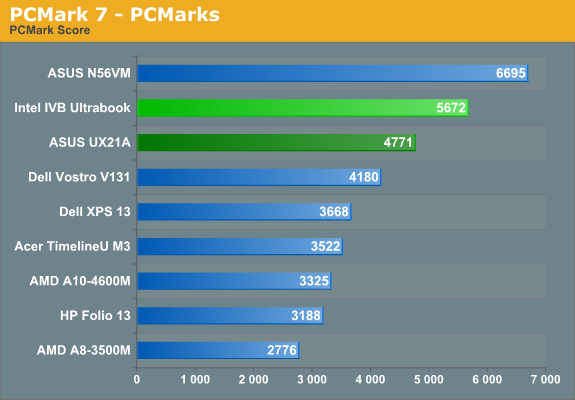
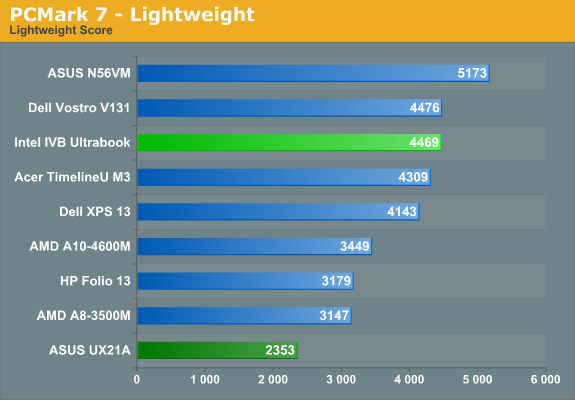
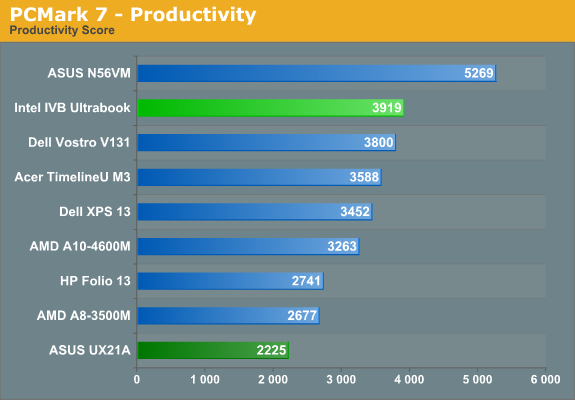
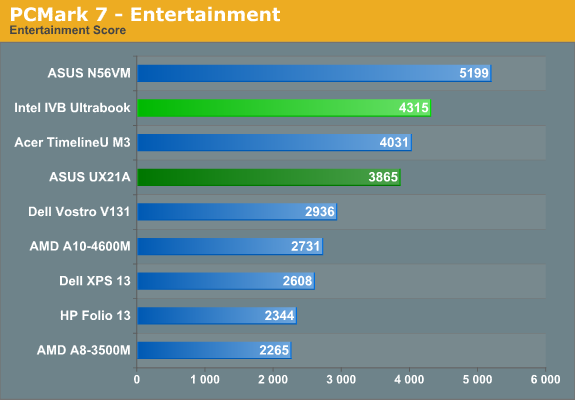
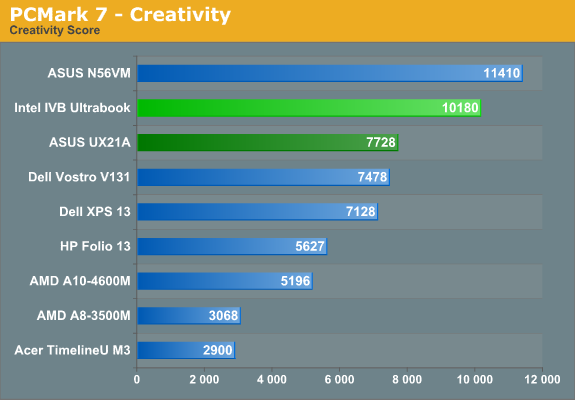

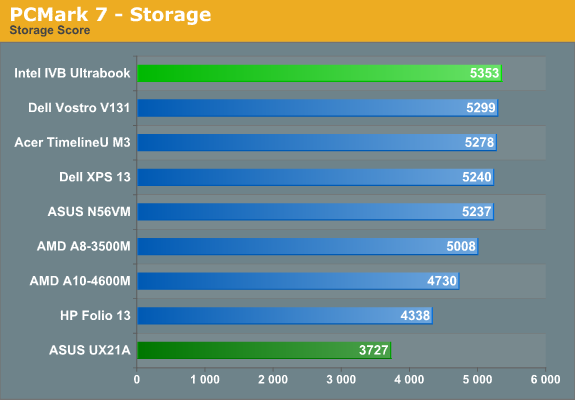
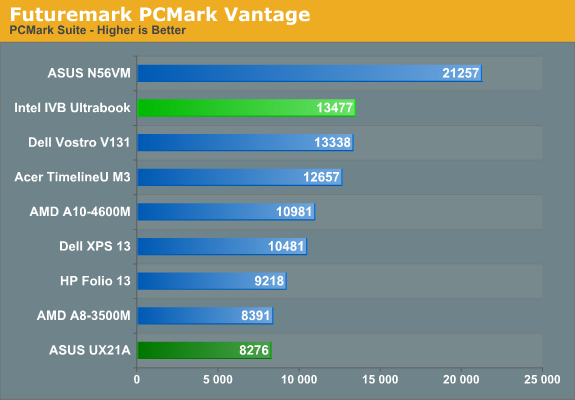
We’ve mentioned before how much PCMark scores tend to skew towards laptops with SSDs. The good news is that all of the laptops in our charts for this article have SSDs; the bad news is that there’s another element at play that can dramatically influence a couple of scores. That element is Intel’s Quick Sync technology, which is supported by PCMark 7 and has a major impact on the Creativity and Computation test suites, and a lesser impact on the Entertainment suite. We don’t know exactly how much the higher Computation/Creativity scores affect the overall score, but it’s definitely a factor. To that end, PCMark Vantage is a nice look at overall performance without any Quick Sync optimizations present.
Given what we just said about Quick Sync, it’s not too surprising that Ivy Bridge—even in ULV attire—dominates many of the PCMark 7 charts. The ASUS UX21A standings are severely hampered by the SanDisk U100 SSD, making direct comparisons with the PUB-RD Ultrabook impossible in PCMark. Look at our prototype scores however and we find that it offers performance that’s generally better than a last-generation standard voltage Sandy Bridge laptop (e.g. the Dell Vostro V131).
Without testing every single laptop with the same SSD (and arguably with and without Quick Sync enabled), PCMark scores only give us an abstract view of system performance. As we’ve noted in the past, every single laptop in our charts is going to be “fast enough” for typical home and business use. The real differentiator between laptops is going to be build quality, form factor, design elements, and what applications you plan on running (e.g. complex number crunching apps would benefit from more CPU performance, while games will benefit from faster graphics). To help flesh out our understanding of Ivy Bridge ULV performance and how it compares to other laptops, we’ve got CPU-centric and GPU-centric tests.
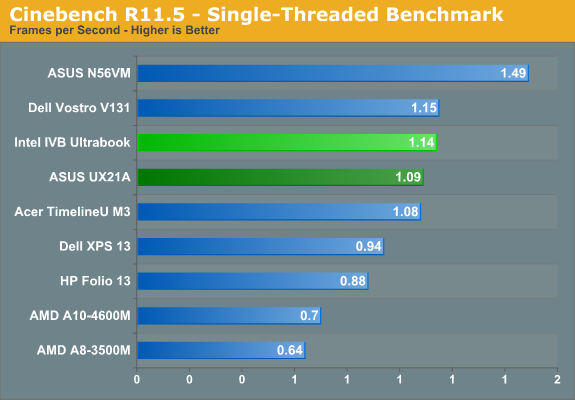
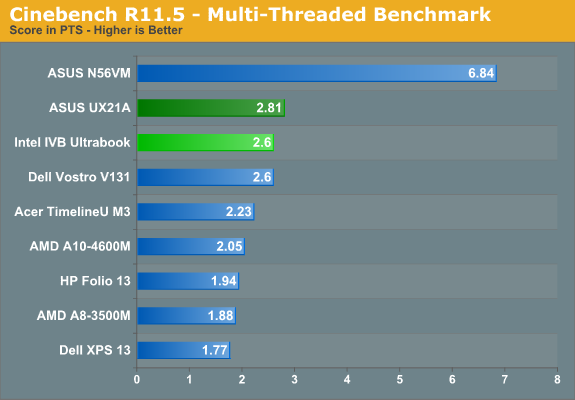
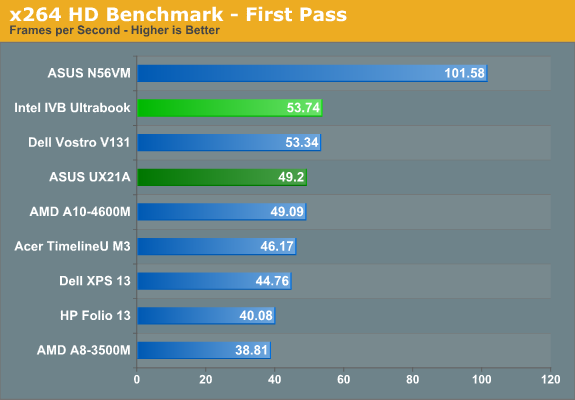
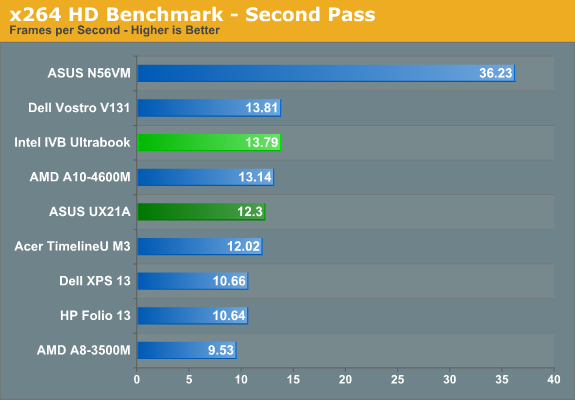
Cinebench is a great look at pure CPU performance, and the workload is such that L3 cache sizes frequently don’t come into play. Obviously quad-core IVB is in a different category, but of the dual-core parts that we’ve included, IVB ULV tops the charts. The ASUS UX21A with its slightly faster Core i7 processor leads in the multi-threaded test, but apparently thermal constraints keep it from hitting maximum Turbo in the single-threaded test and the larger Core i5 Ultrabook comes out ahead. We see a similar situation with the x264 benchmarks, with the Ivy Bridge prototype Ultrabook beating the in-theory-faster UX21A CPU by around 10%.
I have to admit I’m not a big fan of 11.6” laptops to begin with, probably because I’m 6’3” (190cm) and have trouble typing on the smaller keyboards, but thermals are another factor. I’ve stated before that personally, 13.3” or 14” laptops are my favorite size, and I don’t mind 15.6” laptops if they come with added performance and features. Given the comparison between the PUB-RD prototype and the UX21A, I’d rather have a slightly larger Ultrabook. The ASUS UX31A/UX32A on the other hand…it looks like those are going to be the Ultrabooks to beat this round.










64 Comments
View All Comments
Oatmeal25 - Thursday, May 31, 2012 - link
Shift+End.Ultrabooks are almost there (for anyone doing more than web.) They just need to take fewer shortcuts with screen, GPU and storage and put less emphasis on CPU. Consistent build quality and lower prices wouldn't hurt either.
Wish Intel would work harder on their Integrated GPUs. I have an HD3000 in my Lenovo Y570 and when it's in use (also has a GT 555M with Optimus switching) dragging windows in Win7 is choppy.
JarredWalton - Thursday, May 31, 2012 - link
But there's no "End" key, which is why I list the Fn+Right key combination. Just using Shift+Right, or Control+Shift+Right doesn't trigger the issue I experienced much if at all; it's when I have to hit a lot of keys that it gets iffy. Like Fn+Control+Shift+Right to do "select to end of document" frequently ends up with the Control key registered as pressed when I'm done. So then I have to tap it just to let the OS know I've released the key.mikk - Thursday, May 31, 2012 - link
JarredWalton: "The HD 4000 ULV clocks are interesting. Base clocks are very low, but maximum clocks are quite high. WIth better cooling and configurable TDP (e.g. TDP Up or whatever it's called), it's possible there will be Ultrabooks that manage to get within 10% of the quad-core HD 4000 for graphics performance. However, Intel is only guaranteeing a rather low 350MHz iGPU clock, so in practice I bet average gaming clocks will be in the 700-900MHz range"Why you don't record the frequency used in games with gpu-z? This would be interesting. And it would be also interesting to see how it performs with a disabled cpu turbo to give more headroom for the iGPU.
JarredWalton - Thursday, May 31, 2012 - link
Working on it (see above). I'll update the article when I have some results.thejoelhansen - Thursday, May 31, 2012 - link
I see that next gen quad core part, 3720QM (2.6 GHZ), in the mix. However, there wasn't a quad core from last gen. Any chance of an update with a 26xx - 27xx part?I realize the article was more about the ULV and new dual core IVB chips for ultra books, but I'm kinda curious how all these new duals stack up to last gen's quads. Might be interesting... ?
Anyway, thanks for the well written and documented article and benchmarks (as always). :)
JarredWalton - Thursday, May 31, 2012 - link
There's always Mobile Bench. Here's the comparison you're after:http://www.anandtech.com/bench/Product/608?vs=327
Yangorang - Thursday, May 31, 2012 - link
So do you guys know what kind of frequencies the GPU was running at while benchmarking games? I am curious as to whether better cooling / lower ambient temps could actually net you signaficantly better or worse framerates.name99 - Thursday, May 31, 2012 - link
"There is an unused mini-PCIe slot just above the SSD, which might also support mSATA"The last time we went through this (with comments complaining about companies using their own SSD connectors, not mSATA) the informed conclusion seemed to be that mSATA was, at least right now, a "proto-spec" --- a nice idea that was not actually well-defined enough to translate into real, inter-compatible, products. The wikipedia section on mSATA, while not exactly clear, seems to confirm this impression.
So what's up here? Is mSATA a real (as in, I can go buy an mSATA drive from A, slot it into an mSATA slot from B, and have it work)? If not, then why bother with speculation about whether slots do or don't support it?
JarredWalton - Thursday, May 31, 2012 - link
It was more a thought along the lines of: "If this were a retail laptop, instead of an SSD they could use and HDD and put an mSATA caching drive right here." Can you buy mSATA drives and use them in different laptops? I don't know -- Apple and ASUS for sure have incompatible "gumstick drive" connections. I was under the impression that mSATA was a standard but apparently it's not very strict if that's the case. It would benefit the drive makers to all agree on something, though, as right now they might have to end up making several different SSD models if they want to support MBA, Zenbook, other mSATA, etc.Penti - Friday, June 1, 2012 - link
mSATA is a standard, that Apple and Asus don't use. You can normally use the mSATA slot for a retail mSATA SSD or any conforming product. Some mSATA-slots can also support PCIe obviously, but they should be few in todays laptops. Lenovos, HPs and DELL should be just fine running a real SSD instead of a cache drive there. Just look at what other users have done on the same model to be sure. They only appear to be stupid about it mSATA SSD + HDD is an almost perfect solution. mSATA is specified by SATA-IO in SATA 3.1 specifications and an earlier JEDEC specification specifies the mechanical design i.e. same size as a normal mini PCIe card. Not all mSATA slots will have PCIe though and not all mini PCIe slots will support SATA, you really have to know before hand, it requires some additional circuitry to have a switchable/multisignal slot. It's not like it is costly for Asus and Apple to order their custom designs. You can question Asus decision though. Apple made theirs before mSATA had made any headway. It's not like 256GB mSATA SSDs aren't around. Sandisk (that Asus uses) have theirs in various form-factors though, both custom and standardized, but including mSATA sandisk.com/business-solutions/ssd/form-factor-development It's they who finance and produces different boards for different customers, as it's fairly easy PCB's and they know the electrical requirements already it's not a big deal.